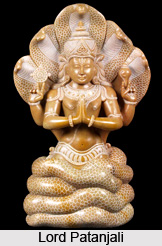 The desa bandhah cittasya dharana sutra describes about the focussing of consciousness to one single matter, termed as concentration. Oen can achhieve such a state of concentration after only one has achieved mastery over the five stages of yogic practice. Dharana stands for cantering one`s attention; it can be accomplished only when the mind learns to stay steady all alone. However, this is not easy to capture. It requires constant care and attention, foremost practice. Once a sadkaka has achieved success in the states of pranayama and pratyahara, thorugh regulating energy flow and developing will-force, he grows unmoved to the tumults of the outer world.
The desa bandhah cittasya dharana sutra describes about the focussing of consciousness to one single matter, termed as concentration. Oen can achhieve such a state of concentration after only one has achieved mastery over the five stages of yogic practice. Dharana stands for cantering one`s attention; it can be accomplished only when the mind learns to stay steady all alone. However, this is not easy to capture. It requires constant care and attention, foremost practice. Once a sadkaka has achieved success in the states of pranayama and pratyahara, thorugh regulating energy flow and developing will-force, he grows unmoved to the tumults of the outer world.
Desa Place, spot, region
Bandhah binding, combining, connecting, uniting, fixing
Cittasya of mind, of consciousness
Dharana the act of holding, keeping the mind collected,
Concentration
Fixing the consciousness on one point or region is concentration (dharana).
Dharana means focus of attention. Centreing the attention on a chosen point or area, within or outside the body, is concentration. By it the functions of the mind are checked and brought to one focal point.
Once mastery of the five stages of yoga from yama to pratyahara is achieved, the art of focusing the mind and consciousness is guaranteed. Dharana is established when the mind learns to remain steady on its own, or hold on to an unmoving object.
Through the practice oiyama and niyama, the sadhaka develops emotional firmness. Through asana, he keeps his body, the abode of the soul, free from disease. In pranayama, he learns to stop the dispersion of energy by regularising its flow for proper distribution all through his body and mind. Through pratyahara, he develops will-power, detaches himself from the organs of senses and acquires precision in thought.
 This is the beginning of culturing the brain. Once he has become unresponsive to worldly matters, he is fit to continue on the inner quest, enriching the mind through dharana. Dhyana and samadhi lead the consciousness on the innermost quest (amaratma sadhana), to the soul itself.
This is the beginning of culturing the brain. Once he has become unresponsive to worldly matters, he is fit to continue on the inner quest, enriching the mind through dharana. Dhyana and samadhi lead the consciousness on the innermost quest (amaratma sadhana), to the soul itself.
The eight components of astahga yoga are interwoven, though each is delineated individually for the sake of convenience. They are subdivided into the external quest (bahiranga sadhana), the internal quest (antarahga sadhana) and the innermost quest (antaratma sadhana), which facilitates even the naïve to learn to concentrate, step by step, on concrete forms by systematic practice. Having readied maturity and refinement, they are able to fathom their inmost thoughts and feelings (11.53).
For instance, most people, even most yoga practicians, are under the impression that asanas are only external and physical. This sutra removes that misapprehension. Patanjali defines concentration as the cantering of attention either within or outside the body. If, in performing an asana, one directs the organs of action and senses of perception towards the mind, and the mind towards the core, external sadhana is transformed into internal sadhana. If the limbs, the senses of perception, the mind and the discriminative intelligence are then repressed and merged with the energy of the soul, this becomes the innermost sadhana. If one performs each asana passionately, blending with integrated attention every part of the body, the digressing mind and the discriminative intelligence with the soul constitutes spiritual practice.
In asana, the initial commitment or passion lifts itself, through concentration, to the level of total absorption. Such practice brings modesty, without which dissemination of the subtle levels is impossible.
Dharana is the art of reducing the disturbances of the mind and ultimately eliminating them entirely, so that the knower and the known become one (1.41).
Dharana may be focused on external or internal objects. External objects should be auspicious and associated with transparency. Internally, the mind penetrates the soul, the core of one`s being - the object is, in reality, pure existence.
Sri Vyasa`s commentary on this sutra indicates specific parts of the body as being suitable for concentration. They comprise the sphere of the navel (nabhi-cakra), the lotus of the heart (hrdaya pundarika), the centre of the head (miirdhani), the shining light (jyotisi or ajhacakra), the tip of the nose (nasika-gra) and the root of the tongue (jihvagra). As attention is set on these inner points, one gradually becomes engulfed first in oneself (sasmita) and then in one`s soul, atman.




















